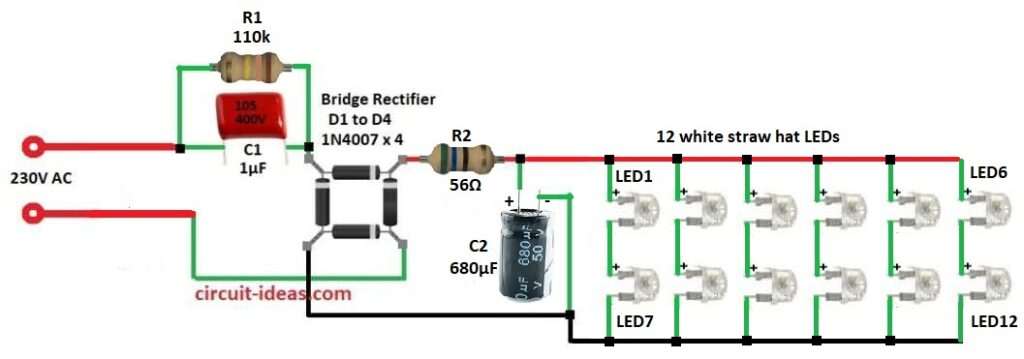This simple LED light circuit is made to work directly with the 230V AC mains supply.
It uses a capacitive dropper to control the current effectively.
This clever design powers a group of LEDs arranged in a series parallel design making it an easy and cost effective choice for lighting that runs on mains power.
The circuit shines a bright white light and does not need a big transformer, which makes it perfect for situations where low power lighting is needed.
Circuit Working:

Parts List:
| Component Type | Value/Specification | Quantity |
|---|---|---|
| Resistors | 110k 1/4W | 1 |
| 56Ω 2W | 1 | |
| Capacitors | PPC 1µF 400V | 1 |
| Electrolytic 680µF 50V | 1 | |
| Semiconductors | Bridge Rectifier 1N4007 | 4 |
| LEDs | White Straw Hat | 12 |
The circuit works by changing high voltage alternating current AC into a safer direct current DC voltage that can power LEDs.
Below is how each part of the circuit works:
Capacitor Dropper C1:
This part is really important because it limits the current to a safe level, which helps avoid overheating that could damage the components.
It uses reactance to drop the voltage instead of using resistors.
Resistor R1:
This resistor helps to discharge the capacitor C1 when the circuit is unplugged, making sure any leftover charge is safely released.
This is important to reduce the chance of electric shock.
Bridge Rectifier D1-D4:
The bridge rectifier changes the incoming AC voltage into pulsating direct current.
It uses four diodes arranged in a way that allows it to convert both halves of the AC wave creating a steady flow of current.
Smoothing Capacitor C2:
This smoothing capacitor is key for cleaning up the rectified DC output.
It helps to reduce any flickering in the LEDs, which improves their performance and lifespan.
This resistor is crucial for managing the initial surge of current that goes to the LEDs preventing any sudden spikes that could harm them.
LED Array LED1 to LED12:
The LEDs are set up in parallel groups which helps to evenly distribute the voltage and current across the array.
This setup is essential for ensuring they work well and shine brightly.
Formulas with Calculations:
Below mentioned are the formulas with calculations for Simple Mains Powered LED Light Circuit:
Reactance of the Capacitor Dropper C1:
The reactance of a capacitor in an AC circuit is given by:
Xc = 1 / (2 * π * f * C)
where,
Xcis the capacitive reactance in ohmsπis 3.1416fis the frequency Hz for mains f = 50HzCis the capacitance in farads
Calculation:
where, C = 1µF = 1 × 10⁻⁶ F and f = 50Hz:
Xc = 1 / (2 * 3.1416 * 50 * 1 × 10⁻⁶)
Xc = 1 / (0.000314)
Xc = 3185Ω
So, the capacitor limits the current with a reactance of approximately 3185Ω.
Current Through the Circuit (I):
Using ohms law:
I = V / Xc
where,
Iis the current in ampsVis the mains voltage of 230V ACXcis the capacitive reactance in ohms
Calculation:
I = 230V / 3185Ω
I = 0.0723A or 72mA
The circuit allows a current of approximately 72mA, which is sufficient for the LED operation.
Power Dissipation in Resistor R2:
The power dissipated in a resistor is given by:
P = I² * R
where,
Pis the power in wattsIis the current in ampsRis the resistance in ohms
Calculation:
where, I = 0.0723A and R2 = 56Ω:
P = (0.0723)² * 56
P = 0.00523 * 56
P = 0.29W
Since 0.29W is close to the 0.25W limit of a standard resistor a 2W resistor is used for reliability.
How to Build:
To build a Simple Mains Powered LED Light Circuit following steps are required for connections of the circuit
- Gather all the components mentioned in the above circuit diagram
- Connect AC Input directly to mains power of 230V AC
- Connect capacitor C1 in series with the live AC wire to drop voltage.
- Connect resistor R1 parallel to C1 for safety discharge.
- Connect bridge rectifier D1 to D4 to convert AC to DC.
- Connect capacitor C2 across the rectifier output to smooth the voltage.
- Connect R2 in series to limit current to LEDs.
- Connect LED1 to LED12 in parallel groups for better current distribution.
Conclusion:
This Simple Mains Powered LED Light Circuit that runs on mains power is a smart and affordable choice for lighting needs.
By using a capacitor dropper method it gets rid of the need for a big transformer but still works well.
This circuit is perfect for night lights, emergency lights and small indicator lights.
Leave a Reply